
The core idea behind former President Donald Trump’s imposition of tariffs was to reinvigorate domestic manufacturing by discouraging imports and encouraging companies to make products in the United States. In theory, the move aligns with a long-term vision of economic independence and job creation within American borders.
However, critics argue that while the intent may be sound, the execution lacked a crucial preparatory step—establishing sufficient domestic manufacturing infrastructure before implementing such sweeping trade policies. Setting up factories, building supply chains, and training a skilled workforce are long-term endeavors, and the U.S. economy was not fully equipped to handle an abrupt shift away from imports.
As a result, the American consumer has begun to bear the brunt of the policy. Prices of essential goods have risen, and small businesses reliant on affordable imports are facing mounting challenges. Supporters of the policy, many of whom are politically aligned with Trump, remain optimistic and view the short-term sacrifice as a necessary step toward economic sovereignty. On the other hand, many consumers and business owners are voicing concerns over the immediate financial strain.
In the long run, the strategy could potentially hurt foreign economies reliant on U.S. demand, as their exports decline. But in the near term, it is American households—not importers or manufacturers—who are absorbing much of the impact.
A more strategic approach, some suggest, would have been to first invest heavily in domestic manufacturing capabilities before erecting tariff barriers. As the U.S. charts its course in global trade, the balance between bold economic policy and pragmatic execution remains a pressing issue.
















0 Comments